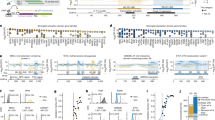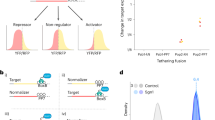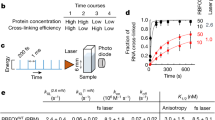Abstract
Replying to: G. A. Collins, J. R. Lipford, R. J. Deshaies & W. P. Tansey Nature 461, 10.1038/nature08406 (2009)
Proteasome-mediated turnover of some1,2, but clearly not all3,4, transcriptional activators is important for their activity. To facilitate the analysis of activator–promoter complex lifetime in vivo, a parameter relevant to this issue, we developed a competition chromatin immunoprecipitation (ChIP) assay in which binding of a native transactivator to its cognate promoters is challenged by a ligand-activated competitor protein with the same DNA-binding specificity. We applied this technique to the yeast Gal4 system5 and concluded that under non-inducing conditions (raffinose media) Gal4–promoter complexes exchange rapidly, but under inducing conditions (galactose media) the activator–promoter complexes are long-lived. Collins et al.6 report that, surprisingly, the addition of oestradiol to yeast lacking Myc–G4–ER–VP16 increased the amount of DNA co-immunoprecipitated with native Gal4.
Similar content being viewed by others
Main
This is a control we had not done, but have subsequently repeated and agree that this is the case (S.A.J. wishes to note that he had requested this control and it erroneously was not done). We thank Collins et al.6 for pointing out this omission. They go on to show that inducing competitor protein activity with 4-hydroxytamoxifen (4HT) results in a significant loss in the intensity of the ChIP signal owing to native Gal4, but that this ligand does not affect the intensity of these ChIP signals in the absence of competitor. They also show significant association of the competitor protein with the promoter, although with a different time course than Gal4 dissociation. We agree that these data indicate that a large fraction of Gal4–promoter complexes are kinetically labile in vivo under these (4HT-containing media) conditions. It is important to note that this odd effect of steroid is not a general problem in the application of this technology to the measurement of other activator–promoter half-lives4.
However, our ChIP data tracking association of the competitor protein do not support the conclusion of a rapidly exchanging Gal4–DNA complex in vivo in the presence of β-oestradiol rather than 4HT. There is no indication that these data are compromised by unanticipated effects of β-oestradiol. Under inducing conditions, much lower levels of association of the competitor protein with GAL promoters were observed when Gal4 was present than in Δgal4 cells when β-oestradiol was used to trigger the competition. These data argue for the presence of a stable, functional Gal4–promoter complex in the presence of galactose and under the particular conditions used in our study5. It may be that the stability of Gal4–promoter complexes are somehow affected by steroid receptor ligands, which would explain the different results observed by ourselves and Collins et al.6 for the association of the competitor protein in our respective experiments.
References
Reid, G. et al. Cyclic, proteasome-mediated turnover of unliganded and liganded ERα on responsive promoters is an integral feature of estrogen signaling. Mol. Cell 11, 695–707 (2003)
Lipford, J. R. et al. A putative stimulatory role for activator turnover in gene expression. Nature 438, 113–116 (2005)
Yao, J. et al. Dynamics of heat shock factor association with native gene loci in living cells. Nature 442, 1050–1053 (2006)
Yu, P. & Kodadek, T. Dynamics of the hypoxia-inducible factor-1-vascular endothelial growth factor promoter complex. J. Biol. Chem. 282, 35035–35045 (2007)
Nalley, K., Johnston, S. A. & Kodadek, T. Proteolytic turnover of the Gal4 transcription factor is not required for function in vivo . Nature 442, 1054–1057 (2006)
Collins, G. A., Lipford, J. R., Deshaies, R. J. & Tansey, W. P. Gal4 turnover and transcription activation. Nature 461 10.1038/nature08406 (2009)
Author information
Authors and Affiliations
Rights and permissions
About this article
Cite this article
Nalley, K., Johnston, S. & Kodadek, T. Nalley et al. reply. Nature 461, E8 (2009). https://doi.org/10.1038/nature08407
Issue Date:
DOI: https://doi.org/10.1038/nature08407
This article is cited by
Comments
By submitting a comment you agree to abide by our Terms and Community Guidelines. If you find something abusive or that does not comply with our terms or guidelines please flag it as inappropriate.



